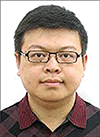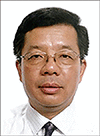The Internet of Things (IoT), which supports ubiquitous information exchange and content sharing among smart devices with little or no human intervention, is a key enabler for various applications. Smart IoT cannot be simply regarded as an upgrade of current IoT by just adding to or replacing sensors/actuators/RFID tags in smart devices. It should be redesigned from the physical layer to the application layer in a bottom-up way. While the traditional-sense IoT paradigm, including the present narrowband IoT (NB-IoT) proposal, aims to provide low-rate, short-range, and relatively stationary connections to the wireless sensors and/or RFID tags, the new architecture is expected to support higher data rates, longer communication ranges, and more flexible mobility for smart devices, with the assistance of some new caching, communication, and computing technologies. These also enable smart IoT to be applied to a broader application area including crowdsensing, crowdsourcing, AR/VR, UAV, and so on, to realize smarter cities, grid, and health, and more intelligent transportation systems.
Fully utilizing the communication, computing, caching, and security technologies can essentially complement the current development of IoT. The resulting new structure may have a wider application over current infrastructure-based cellular networks and traditional sensor-based networks by adopting all these features. However, new features also create unexpected problems that cannot be directly addressed through the traditional approaches designed for low-rate IoT systems. Thus, how to effectively utilize existing capabilities to address the fundamental problems in smart IoT remains challenging. This Special Issue aims at providing timely and comprehensive overviews of the current state of the art in terms of fundamental theoretical innovations and technological advances and toward exploiting smart caching, communications, computing, and cybersecurity for smart IoT networks. There are 12 great articles included in this Special Issue that will have an impact on the field of the smart Internet of Things.
The article “Security and Privacy in the Age of Smart Internet of Things: An Overview from a Networking Perspective” by Dongqing Xie et al. presents the state of the art of the security and privacy issues in the smart IoT world from a networking per-spective, and predicts that IoT systems will be extensively used by hackers to commit their malicious actions given the features of IoT devices and systems. A unique understanding on counter-attacks in both application and theoretical aspects is included.
The article “A City-Wide Real-Time Traffic Management System: Enabling Crowdsensing in Social Internet of Vehicles” by Zhaolong Ning et al. provides an overview of several promising research areas for traffic management in the Social Internet of Vehicles (SIoV). A crowdsensing-based framework to provide timely response for traffic management in heterogeneous SIoV is investigated. A real-world taxi trajectory analysis-based performance evaluation is provided to test the proposed framework.
The article “Vehicular Communication Networks in the Automated Driving Era” by Shan Zhang et al. argues that vehicular communication networks (VCNs) have attractive potential to enhance onboard sensing-based automated vehicles from different perspectives, such as driving safety and transportation efficiency, as well as customer experiences. A case study is conducted to demonstrate that traffic jams can be relieved at intersections with automated driving vehicles coordinated with each other through VCNs.
The article “Software-Defined and Fog-Computing-Based Next Generation Vehicular Networks” by Haijun Zhang et al. proposes a novel software-defined fog computing vehicular network (SDFC-VeNET) architecture based on software-defined networking (SDN) and fog computing (FC), which can guarantee the requirements of less delay and higher mobility for vehicles. The mobility management and resource allocation in SDFC-VeN-ET are analyzed in this article.
The article “CASLP: A Confused Arc-Based Source Location Privacy Protection Scheme in WSNs for IoT” by Guangjie Han et al. proposes a confused arc-based source location privacy (CASLP) protection scheme in WSNs to address the source location privacy (SLP), which is a major security problem for IoT. Compared to a ring-based routing scheme, CASLP can reduce delays and energy consumption at the sacrifice of minor safety time in WSNs.
The article “The Fog of Things Paradigm: Road toward On-Demand Internet of Things” by Guoliang Xue et al. introduces the fog of things (FoT) concept, a paradigm for on-demand IoT. The FoT paradigm features the incorporation of fog computing power, which empowers not only the IoT applications, but more importantly the scalable and efficient management of the system itself. FoT utilizes a flat-structured virtualization plane and a hierarchical control plane, both of which extend to the network edge and can be reconfigured in real time to achieve various design goals.
The article “Data Linkage in Smart Internt of Things Systems: A Consideration from the Privacy Perspective” by Zhipeng Cai et al. investigates the privacy issues toward linkable data in smart IoT systems, which have not been thoroughly studied by the previous works. The available data sources in smart IoT systems and their linkage is discussed. The potential threats are comprehensively elaborated for both individuals and crowds in smart IoT systems.
The article “RF Sensing in the Internet of Things: A General Deep Learning Framework” by Shiwen Mao et al. proposes a general deep learning framework for RF sensing in the IoT and then reviews various RF sensing techniques, deep learning techniques, and canonical RF sensing applications. The proposed framework is applied to fingerprinting, activity recognition, and vital sign monitoring using WiFi channel state information (CSI), and experimental results are presented.
The article “Detecting Confident Information Coverage Hole in Industrial Internet of Things: An Energy-Efficient Perspective” by Lingzhi Yi et al. focuses on the coverage hole detection issue from an energy efficiency perspective. By exploiting the merits of the confident information coverage (CIC) model, the authors develop an energy-efficient CIC hole detection (EECICHD) framework and scheme which detects CIC holes by fully considering the sensor nodes’ energy dissipation as well as their communication abilities.
The article “Price the QoE, Not the Data: SMP-Economic Resource Allocation in Wireless Multimedia Internet of Things” by Wei Wang and Qin Wang conceptualizes a new framework named smart media pricing (SMP) to price the QoE rather than the binary data traffic in IoT multimedia services. By introducing price as a resource (PaaR) in QoE-driven network scheduling in mmIoTs, a new dimension of price-distortion is available in multimedia resource allocation, complementing traditional rate-distortion and power-distortion resource allocation approaches.
The article “On a Novel Deep-Learning-Based Intelligent Partially Overlapping Channel Assignment in SDN-IoT” by Fengxiao Tang et al. focuses on the issue of the massive surge of IoT data traffic and points out the importance of assigning suitable channels to each SDN-IoT switch to avoid potential network congestion. The authors consider how to exploit partially overlapping channel (POC) assignment in SDN-IoT, and envision two deep-learning-based strategies to predict the future IoT traffic load and to adaptively assign the POCs according to the predicted traffic load, respectively.
The article “A Smart Home Gateway Platform for Data Collection and Awareness” by Feng Ye et al. proposes a smart gateway platform for data collection and awareness in smart home networks to accomplish data collection, awareness, and reporting. The proposed network platform supports different types of smart devices, including in-home IoT devices, smartphones, smart electric appliances, and so on. A multi-dimensional awareness plug-in framework is proposed to achieve accurate data awareness at the smart gateway.
Finally, we would like to thank Dr. Tarek S. El-Bawab, Dr. Osman Gebizlioglu, Peggy Kang, Jennifer Porcello, and Joseph Milizzo for their continuous support and valuable comments to improve this Special Issue. We hope that the articles will encourage the readers of IEEE Communications Magazine to contribute to the further development and improvement of the smart Internet of Things.
Biographies

Jun Huang [M’12, SM’16] received his Ph.D. degree (with honors) from the Institute of Network Technology, Beijing University of Posts and Telecommunications, China, in 2012. He is a full professor of computer science with the Chongqing University of Posts and Telecommunications. He was a visiting scholar at the Global Information and Telecommunication Institute, Waseda University, a research fellow in the Electrical and Computer Engineering Department, South Dakota School of Mines and Technology, a visiting scholar in the Computer Science Department, University of Texas at Dallas, and a guest professor at the National Institute of Standards and Technology. He received the outstanding service award from ACM RACS 2017, the runner-up best paper award from ACM SAC 2014, and the best paper award from AsiaFI 2011. He has authored 100+ publications including papers in prestigious journal/conferences. He is an Associate Editor of IEEE Access and KSII Transactions on Internet and Information Systems. He has guest edited several Special Issues of IEEE journals. He has also chaired and co-chaired multiple conferences in the communications and networking areas, and organized multiple workshops at major IEEE and ACM events. His current research interests include network optimization and control, machine-to-machine communications, and the Internet of Things.

Zheng Chang received his B.Eng. degree from Jilin University, Changchun, China, in 2007, his M.Sc. (Tech.) degree from Helsinki University of Technology (Now Aalto University), Espoo, Finland, in 2009, and his Ph.D degree from the University of Jyväskylä, Finland, in 2013. Since 2008, he has held various research positions at Helsinki University of Technology, the University of Jyväskylä, and Magister Solutions Ltd, Finland. From June to August 2013, he was also a visiting researcher at Tsinghua University, China, and the University of Houston, Texas. He has received awards from the Ulla Tuominen Foundation, the Nokia Foundation, and the Riitta and Jorma J. Takanen Foundation for his research work. Currently, he is working at the University of Jyväskylä, and his research interests include signal processing, radio resource allocation, cross-layer optimizations for wireless networks, and green communications.

Chonggang Wang [F] has been with InterDigital since 2009 and is currently an MTS/senior manager leading IoT and big data themes. Prior to that, he had plentiful research experience with NEC Laboratories America-Princeton, AT&T Labs Research, University of Arkansas-Fayetteville, and Hong Kong University of Science and Technology. He has many years of industry experience including R&D, standardization, and university collaboration. He was escalated to IEEE Fellow in 2017 for his contribution to Internet of Things enabling technologies in January 2017. He was invited to serve on the IEEE Computer Society Fellows Committee for 2017 and has reviewed several Fellow applications. He has received several awards from IEEE Communications Society. He has been involved in many IEEE and ComSoc journals/magazines as an Editor-in-Chief, an Associate Editor, and a Guest Editor. He was the co-founder and founding Editor-in-Chief of the IEEE Internet of Things Journal for 2014–2016. He has also co-organized and participated in major ComSoc conferences many times. He was the Vice-Chair of the ComSoc Multimedia Communications Technical Committee for 2012–2014. Currently, he is also an Advisory Board member for IEEE — The Institute.

Yi Qian [SM] is a professor in the Department of Electrical and Computer Engineering, University of Nebraska-Lincoln (UNL). Prior to joining UNL, he worked in the telecommunications industry, academia, and government. Some of his previous professional positions include serving as a senior member of scientific staff and a technical advisor at Nortel Networks, a senior system engineer and a technical advisor at several startup companies, an assistant professor at the University of Puerto Rico at Mayaguez, and a senior researcher at the National Institute of Standards and Technology. His research interests include information assurance and network security, network design, network modeling, simulation and performance analysis for next generation wireless networks, wireless ad hoc and sensor networks, vehicular networks, smart grid communication networks, broadband satellite networks, optical networks, high-speed networks, and the Internet. He is a member of ACM. He was the Chair of the IEEE Communications Society Technical Committee for Communications and Information Security from January 1, 2014 to December 31, 2015. He is a Distinguished Lecturer for the IEEE Vehicular Technology Society. He serves on the Editorial Boards of several international journals and magazines, including serving as the Editor-in-Chief of IEEE Wireless Communications. He is the Technical Program Chair for IEEE ICC 2018.

Hamid Gharavi [LF] received his Ph.D. degree from Loughborough University, United Kingdom, in 1980. He joined the Visual Communication Research Department at AT&T Bell Laboratories, Holmdel, New Jersey, in 1982. He was then transferred to Bell Communications Research after the AT&T-Bell divestiture, where he became a consultant on video technology and a Distinguished Member of Research Staff. In 1993, he joined Loughborough University as a professor and chair of communication engineering. Since September 1998, he has been with the National Institute of Standards and Technology (NIST), U.S. Department of Commerce, Gaithersburg, Maryland. His research interests include smart grid, wireless multimedia, mobile communications and wireless systems, mobile ad hoc networks, and visual communications. He holds eight U.S. patents, and has over 150 publications related to these topics. He was the recipient of the Washington Academy of Science Distinguished Career in Science Award for 2017. He served as a member of the Editorial Board of Proceedings of the IEEE from January 2003 to December 2008. From January 2010 to December 2013 he served as Editor-inChief of IEEE Transactions on CAS for Video Technology. Until recently, he served as the Editor-in-Chief of IEEE Wireless Communications.

Zexian Li is a senior specialist at Nokia Bell Labs, Finland. He received his B.S. and M.S. degrees from Harbin Institute of Technology and his Ph.D. degree from Beijing University of Posts and Telecommunications, P. R. China. From 2000 to 2005, he was a senior research scientist at the Centre for Wireless Communications, University of Oulu, Finland, involved in various national and EU projects including Business Finland (previously TEKES) and EU WINNER. Since 2005, he has been with Nokia, Finland, focused on research and standardization activities on broadband wireless communication systems, most recently on 5G and LTE-A Pro. He led the horizontal topic on direct D2D within the EU FP7 METIS project and is leading the V2X radio interface design in the ongoing EU 5GPPP Phase II 5GCAR project. Currently, his research interests include 5G, wireless communications for vertical applications and future wireless technologies for improving human life.


